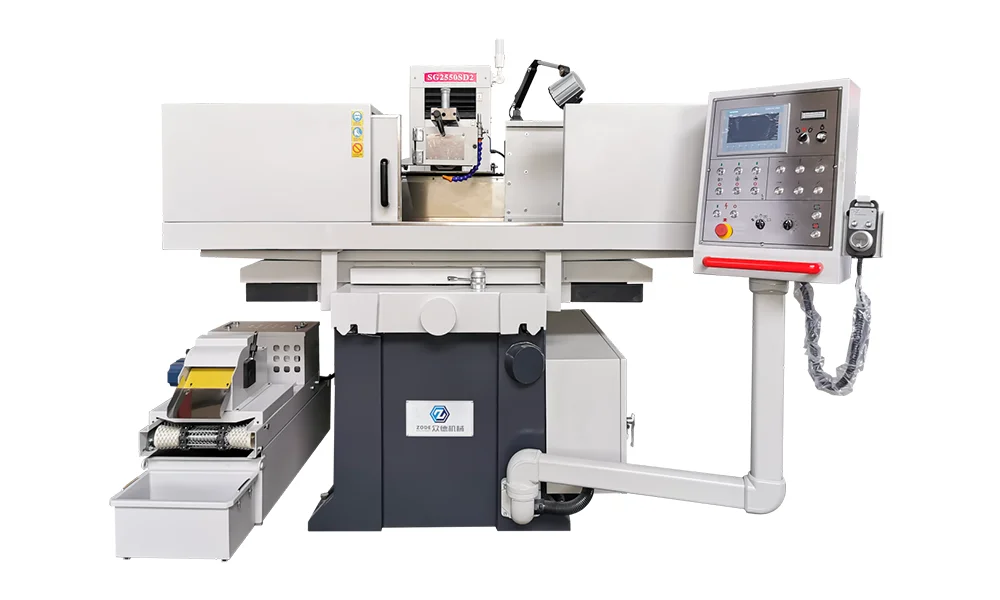Understanding the Role of 2 Axis PLC Automatic Surface Grinder
In modern machining and metalworking industries, precision surface finishing is no longer a luxury—it is a necessity. The 2 axis PLC automatic surface grinder represents a significant technological step forward in achieving consistent flatness, dimensional accuracy, and surface smoothness. Combining programmable logic control (PLC) technology with dual-axis automation, this grinder eliminates manual inconsistencies while improving productivity and repeatability. It is widely adopted in tool manufacturing, mold processing, and high-precision component production. In this blog post, as a high precision surface grinding machine factory, Nantong Zode will share the role of 2 axis PLC automatic surface grinder, its applications, etc.
How the PLC Control System Enhances Surface Grinding Accuracy
The integration of a PLC control system in a 2 axis surface grinder transforms a traditionally manual process into an intelligent, automated workflow. The PLC acts as the “brain” of the machine, managing feed rates, spindle speeds, and table movements with digital precision.
Operators can easily set parameters through an intuitive interface, minimizing setup time and reducing human error. The two-axis configuration—usually comprising the longitudinal and cross-feed movements—ensures precise, synchronized control. This allows for consistent grinding passes, uniform surface textures, and reduced material wastage.
Moreover, the PLC system supports memory storage, enabling users to save and recall machining programs for repetitive jobs, which greatly enhances efficiency in batch production environments.
Precision Engineering in Every Movement
A defining feature of the automatic 2 axis surface grinder is its ability to achieve ultra-fine tolerances through stable mechanical design and servo-controlled movement. The X and Y axes are often driven by precision lead screws or linear guides, ensuring smooth, vibration-free motion.
The grinder’s rigid structure—typically made from high-grade cast iron—absorbs operational vibrations, allowing for micron-level surface accuracy. This mechanical integrity, combined with PLC feedback systems, maintains uniform grinding pressure and prevents overcutting or uneven finishes. The result is a perfect blend of mechanical reliability and electronic intelligence.

Diverse Applications of 2 Axis Automatic Surface Grinding Machine
The 2 axis automatic surface grinding machine is not limited to one industry. Its flexibility makes it indispensable in various sectors requiring high-precision machining.
-
Tool and Die Industry: For shaping, sharpening, and polishing precision dies and molds.
-
Automotive Components: Ensuring flatness and dimensional accuracy in transmission and engine parts.
-
Aerospace Manufacturing: Achieving flawless finishes on critical structural components.
-
Electronics Industry: Producing smooth and level surfaces for semiconductor and connector components.
By adapting easily to different materials—such as steel, aluminum, tungsten carbide, and ceramics—the machine provides manufacturers with a highly adaptable grinding solution.
User-Friendly Operation with Smart PLC Automation
One of the major strengths of a PLC-based surface grinder is its ease of operation. Even operators with minimal CNC experience can quickly learn to control the machine via a user-friendly touch screen interface. Automated cycles—like roughing, finishing, and spark-out passes—can be programmed with high precision.
The PLC system also includes safety and diagnostic features, such as overload protection and real-time error alerts, reducing downtime and maintenance costs. In many advanced models, the inclusion of a digital readout (DRO) system further enhances the operator’s control and monitoring capabilities, ensuring optimal process stability.
Efficiency and Consistency in Industrial Production
In high-volume manufacturing, consistency is key. The 2 axis automatic surface grinder ensures repeatable accuracy across multiple workpieces without operator fatigue or variation.
Automation drastically reduces cycle time while maintaining tight tolerances. Once the grinding cycle is set, the operator can perform other tasks, increasing overall shop floor productivity. Combined with reduced rework and improved surface quality, this machine becomes an asset in cost optimization and throughput efficiency.
Maintenance and Longevity of PLC Surface Grinders
Durability and reliability are core advantages of PLC-controlled grinders. Routine maintenance typically includes lubrication, coolant filtration, and periodic calibration checks. The PLC interface simplifies maintenance scheduling by tracking operational hours and alerting users of upcoming service intervals.
Because these machines employ high-quality linear bearings, sealed motors, and dust-protected electrical systems, they maintain accuracy over years of operation with minimal wear. In long-term production environments, this translates to reduced downtime and a higher return on investment.
Integration with Smart Manufacturing and Industry 4.0
As industries move toward Industry 4.0 and digital transformation, the 2 axis PLC automatic surface grinder fits seamlessly into smart manufacturing ecosystems. Modern models can connect to factory networks for remote monitoring, data collection, and performance analysis.
This data-driven approach allows manufacturers to track productivity, optimize machine parameters, and predict maintenance needs before issues arise. The combination of automation and connectivity marks a significant leap in precision engineering and operational intelligence.
Future Innovations in PLC Automatic Surface Grinding Technology
The evolution of surface grinding technology continues to focus on precision, automation, and sustainability. Future PLC automatic grinders are expected to incorporate adaptive AI control systems that self-adjust grinding parameters based on real-time sensor feedback.
Energy-efficient drives and eco-friendly coolant systems will further reduce operational costs and environmental impact. Additionally, the integration of robotic loading systems will enable continuous, unattended production—paving the way for truly smart, lights-out manufacturing.
Conclusion
The 2 axis PLC automatic surface grinder is more than a machine—it’s a strategic investment in efficiency, accuracy, and future-ready manufacturing. By merging mechanical excellence with intelligent automation, it meets the growing demands of precision machining industries worldwide.
Whether used in toolrooms, production lines, or research facilities, this grinder delivers consistent results, simplified operation, and scalable performance. In a competitive market where quality and productivity define success, adopting a PLC-controlled surface grinder is a decisive move toward smarter, more efficient production.
www.zodemc.com
Nantong Zode
